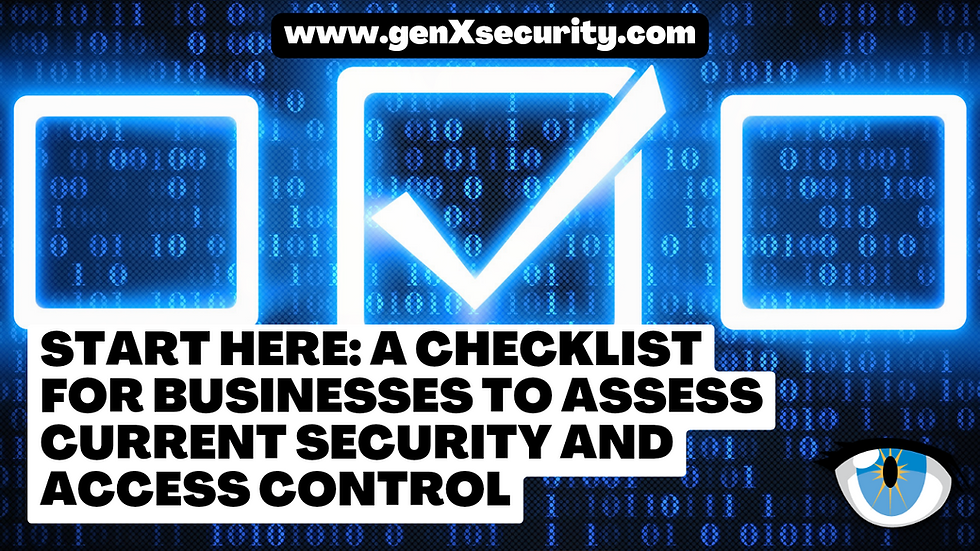Exploring Keyless Access Control Systems for Business Security: Features, Benefits, Overall Security
- GenX Security Solutions
- Feb 5, 2024
- 3 min read
In the rapidly evolving landscape of business security, keyless access control systems have emerged as a cornerstone technology, revolutionizing the way businesses manage and safeguard their premises. These advanced systems leverage cutting-edge technology to provide secure, efficient, and convenient access for employees and authorized personnel. In this blog post, we will delve into the major types of keyless access control for businesses, shedding light on their features, benefits, and how they contribute to overall security.

1. Electronic Keypads:
One of the earliest forms of keyless access control, electronic keypads, remains a popular choice for businesses. These systems require users to input a predefined code to gain access, enhancing security by eliminating the need for traditional keys. With features like customizable access codes, audit trails, and tamper alerts, electronic keypads offer a versatile and effective solution for businesses of all sizes.
Radio-Frequency Identification (RFID) technology has gained prominence in business access control, allowing for seamless and contactless entry. RFID cards or fobs contain unique identifiers that are read by proximity readers, granting access to authorized personnel. This technology ensures swift and secure entry, making it a preferred choice for businesses with high traffic areas.
3. Biometric Access Control:
Biometric access control systems have taken security to the next level by utilizing unique physiological or behavioral characteristics for verification. Fingerprint scanners, facial recognition, and iris scanners are common biometric methods, offering unparalleled accuracy and eliminating the risk of unauthorized access due to lost cards or forgotten codes.
4. Mobile Access Control:
The integration of smartphones into daily life has paved the way for mobile access control systems. Businesses can now leverage mobile devices as digital keys, allowing employees to gain entry through Bluetooth or NFC technology. This type of access control enhances convenience and flexibility while maintaining a high level of security.
5. Smart Card Systems:
Smart card access control systems utilize embedded microchips to store and transmit data. These cards can be programmed to grant specific access permissions, making them a versatile solution for businesses with varying security requirements. Smart card systems are known for their durability, and they can also serve multiple purposes within an organization, such as doubling as employee ID cards.
6. Keypad with Proximity Card:
Combining the security of electronic keypads with the convenience of proximity cards, this hybrid system offers a dual-layered approach to access control. Users can input a code and present a proximity card for enhanced security, making it an ideal solution for businesses seeking robust protection against unauthorized entry.
7. Cloud-Based Access Control:
Cloud-based access control systems have gained popularity due to their scalability and remote management capabilities. Businesses can centrally control and monitor access permissions through a web-based platform, providing real-time insights and making it easier to manage multiple locations.
8. Time and Attendance Integration:
Keyless access control systems are increasingly integrated with time and attendance tracking, streamlining administrative tasks for businesses. This integration helps in automating attendance records and ensures that access is granted only during specified hours, enhancing overall security protocols.
9. Visitor Management Systems:
Businesses often need to manage the access of visitors efficiently. Visitor management systems, integrated with keyless access control, enable businesses to issue temporary credentials, track visitor movements, and enhance security measures during events or special occasions.
10. Artificial Intelligence in Access Control:
The integration of artificial intelligence (AI) is transforming keyless access control, enabling systems to adapt and learn from user behavior. AI-driven access control systems can detect anomalies, identify potential security threats, and continuously improve their functionality, providing businesses with a proactive approach to security.
As businesses strive to enhance their security measures, keyless access control systems stand at the forefront of technological innovation. Electronic keypads, RFID, biometrics, mobile access, smart cards, hybrid systems, cloud-based solutions, time and attendance integration, visitor management, and AI-driven access control collectively contribute to a robust and comprehensive security framework. By staying abreast of the latest advancements in keyless access control, businesses can fortify their premises, safeguard assets, and ensure the safety of their personnel, ultimately fostering a secure and productive working environment.
Wondering which technology would be the best choice for your location? Please contact us for a fast, fair, and always free customized quote for your business access control.








![2020 Roaring Twenties Winner Badge[44136].jpg](https://static.wixstatic.com/media/c44162_312513fcb3514e3ca71a2a18b458369a~mv2.jpg/v1/fill/w_129,h_52,al_c,q_80,usm_0.66_1.00_0.01,enc_avif,quality_auto/2020%20Roaring%20Twenties%20Winner%20Badge%5B44136%5D.jpg)





























Comments